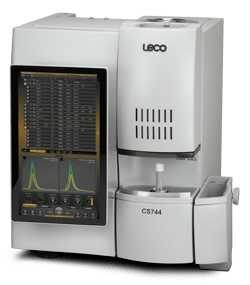Our innovative analytical instrumentation provides users with solutions for a wide range of applications. We want to help your lab succeed, which is why we share examples of the processes, methods of analysis, and results our instruments can obtain in the form of application notes. We want our current and potential customers to feel at ease with our instrumentation in the lab, and our application notes highlight the right instrument for each specific application.
Application Spotlight: Our CS744 for Carbon and Sulfur Analysis in Metals
 The detection of carbon and sulfur in alloys and ferroalloys is important to the quality of these metals. The carbon level influences properties such as hardness, ductility, weldability, and wear resistance, whereas sulfur is either considered a contaminant or desired additive as its levels influences the malleability of the metal.
The detection of carbon and sulfur in alloys and ferroalloys is important to the quality of these metals. The carbon level influences properties such as hardness, ductility, weldability, and wear resistance, whereas sulfur is either considered a contaminant or desired additive as its levels influences the malleability of the metal.
Therefore, testing for carbon and sulfur in your own lab for quality control parameters is of the upmost importance. This is where our CS744 for the determination of carbon and sulfur comes in. With features such a high-frequency combustion furnace, improved IR cell design, and our user-friendly Cornerstone brand software, you’ll be able to streamline your analysis and have confidence in your results. The CS744 is ideal for a number of applications including primary steels, finished metals, ores, and other inorganic materials; it is also able to perform detection in typically difficult, low-level samples.
You can see the CS744 in action in our latest application notes. The CS744 was used to determine the carbon and sulfur level in both low carbon ferroalloys, as well as iron, steel, nickel-base, and cobalt-base alloys. Check out the application notes below!
Carbon and Sulfur Determination in Low Carbon Ferroalloys
Carbon and Sulfur in Iron, Steel, Nickel-Base, and Cobalt-Base Alloys

